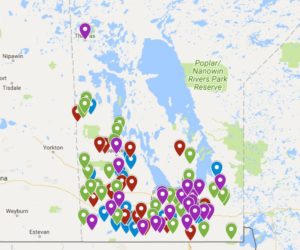Manitoba Chimney Swift Initiative Monitoring 2018 – Part 4, Tracking Down Swifts in New Communities Across Manitoba
 In 2017, Marshall Birch, a former summer student with the Manitoba IBA Program, completed a GIS project with MCSI. For anyone not familiar with GIS, it stands for Geographical Information Systems. These are incredibly powerful computer modelling programs, and among their many uses, can be used to map information and use that information to build predictive models based on the information provided. In this case, Marshall was able to create a predictive model for Chimney Swift habitat in Manitoba. As part of his model, he estimated, based habitat and land-use information, where we might find Chimney Swifts in the Province of Manitoba. If anyone is interested, his report is posted on our website at
In 2017, Marshall Birch, a former summer student with the Manitoba IBA Program, completed a GIS project with MCSI. For anyone not familiar with GIS, it stands for Geographical Information Systems. These are incredibly powerful computer modelling programs, and among their many uses, can be used to map information and use that information to build predictive models based on the information provided. In this case, Marshall was able to create a predictive model for Chimney Swift habitat in Manitoba. As part of his model, he estimated, based habitat and land-use information, where we might find Chimney Swifts in the Province of Manitoba. If anyone is interested, his report is posted on our website at Ahead of the new season, Lynnea Parker, who is now working as an intern on bird projects with Nature Manitoba, has looked over the list of possible sites, and tried to work out which ones have potential for swift habitat (suitable chimneys). Marshall’s model could predict whether towns and cities met certain criteria, such as proximity to certain habitats, age of settlement and even in some cases, spraying of insecticide, but it could not know whether a settlement had suitable chimneys. Lynnea based her search on a few resources such as the excellent Manitoba Historical Society website and Google Streetview. She came up with a rudimentary system of high likelihood (meaning there are a few good looking chimneys), through to very unlikely (meaning there were no obvious chimneys). You can see the list of towns in the attached – and by clicking the link where we mapped them – https://drive.google.com/ope
Ahead of the new season, Lynnea Parker, who is now working as an intern on bird projects with Nature Manitoba, has looked over the list of possible sites, and tried to work out which ones have potential for swift habitat (suitable chimneys). Marshall’s model could predict whether towns and cities met certain criteria, such as proximity to certain habitats, age of settlement and even in some cases, spraying of insecticide, but it could not know whether a settlement had suitable chimneys. Lynnea based her search on a few resources such as the excellent Manitoba Historical Society website and Google Streetview. She came up with a rudimentary system of high likelihood (meaning there are a few good looking chimneys), through to very unlikely (meaning there were no obvious chimneys). You can see the list of towns in the attached – and by clicking the link where we mapped them – https://drive.google.com/opeCheck out the list of potential sites at
In a few cases, we have ground-truthed some of these settlements, and we were delighted to find that the search by Lynnea appeared to correspond well with what was present on the ground,i.e. there were suitable chimneys. However, what we would love to do is ground truth the model now, and see if there are swifts in many of these towns that Marshall’s project predicted.
The challenge we are therefore setting to Manitoba’s birding community is to get out and look when you are out and about. For example, if you have a cottage near Pelican Lake, then would it be possible to take an evening stroll in Dunrea or Ninette to look for swifts? Or if you are on a birding trip to Riding Mountain, rather than stop in on the excellent Wasagaming sites, maybe check out Erickson instead. And why not take an evening stroll in Lockport with an ice cream and look for some swifts? In Morden, it’s about time someone sat out at the Pembina Arts Centre and determined once and for all if swifts are using that site.
If you are interested in checking one or more of the towns on the map, then please let us know!
– Tim Poole for the MCSI team
